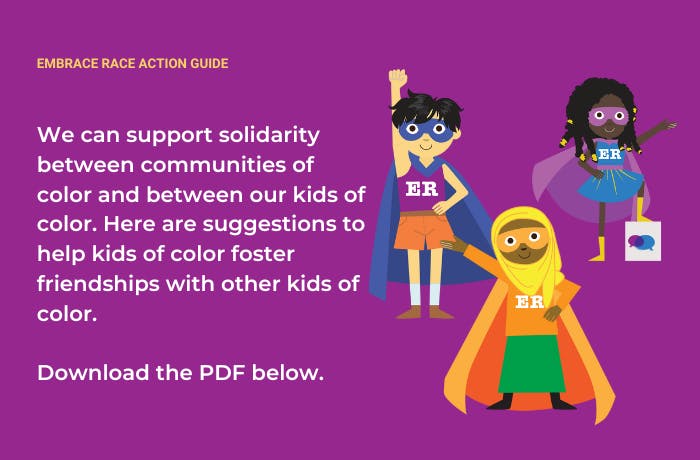How to nurture friendships between kids of color

Conversations about race and race relations in the US still are often framed in terms of how “White vs. Black” or “White vs. non-White” people interact and experience the world. But children growing up in our multicultural democracy increasingly interact across many different racial and ethnic lines. When relationships among communities of color do draw attention, the focus is typically on the tensions among them, which is important, but far from the whole picture.
So how can we center and honor connections between people of color and help kids of color foster friendships with other kids of color? Here are some suggestions. (Check out the related webinar: Why and How Parents & Caregivers Can Nurture Friendships Between Kids of Color.)
1) Model these relationships.
Our kids learn by watching. Show them instead of telling them. This starts with an audit of our own circle of friendships. If we are parents and caregivers of color, how many of our own friends are people of color? Do we have diverse friends of color? How close are we to them? How often do our kids see and interact with our friends of color? Learning through modeling is the most powerful and enduring form of behavior shaping.
2) Talk about friendships.
Yes, we want friendships to happen organically, and on our kids’ own terms. It’s also the case that most kids need some level of support from caregivers in navigating the complexities of making and keeping friends. Start with easy conversational questions that you can build over time: “Who did you play with during recess today?” “What do you like about her/him/them?” Regular conversations like these offer opportunities for kids to develop curiosity and insights about their preferences and also give parents and caregivers openings to ask more pointed questions or make suggestions.
3) Encourage and nurture connections.
Offer gentle nudges about connecting with other kids of color. Build on earlier conversations about friendships and how connecting with other kids of color might offer benefits such as kinship based on similar identities, validation of shared experiences, or learning about new cultures. For example, “I notice you talking about Mia a lot. It sounds like she also speaks another language at home like you. How cool! Maybe we should invite Mia and her dad over for a playdate.”
4) Connect outside of school and neighborhood.
If your child of color does not have access to other kids of color at school, help make the connections. Invite a neighbor or a co-worker’s child for a playdate. Sign up for a music or sports program or anything else your child shows interest in. Broaden your search beyond your immediate area, especially if your school or neighborhood is racially segregated. Organizations that target kids of color such as Cinnamongirl, My Brother’s Keeper Alliance, and Radical Monarchs are great examples.
5) Become a social entrepreneur.
If opportunities and access are limited, consider becoming a social entrepreneur. Create your own playgroup or organization for kids of color. Parents often make the best entrepreneurs, especially when our kids are involved. (Melissa and Andrew – EmbraceRace!) Start small, experiment, and build. Organize weekly or even monthly gatherings. If meeting in person is prohibitive for whatever reason, consider virtual meet ups. Regardless of whether it’s in-person or virtual, make it fun and activity-driven. Shared interests and hobbies are the fastest and easiest ways to connect with others. This is true for kids and adults! Maybe reading, cooking, Minecraft, music, movies, Legos, or even advocacy.

Anatasia Kim
Get Insights In your Inbox
Join the EmbraceRace community! You will receive the newsletter with our latest on race & kids, including upcoming events and opportunities, resources, community news and curated links.
Subscribe


